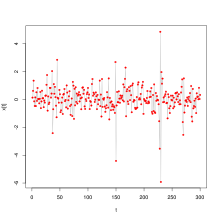ARCH models
ARCH models (ARCH, acronym for: A uto R egressive C onditional H eteroscedasticity , German autoregressive conditional heteroscedasticity ) or autoregressive conditional heteroscedastic time series models are stochastic models for time series analysis , with the help of which, in particular, financial mathematical time series with non-constant volatility can be described. They are based on the assumption that the conditional variance of the random model errors depends on the realized random error of the previous period, so that large and small errors tend to occur in groups. ARCH models were developed by Robert F. Engle in the 1980s. In 2003 he was awarded the Nobel Prize in Economics for this.
definition
A time series is called an ARCH (p) time series if it is defined recursively by
where with are real, nonnegative parameters, and the process consists of independent, identically distributed random variables with and .
properties
For ARCH models, under the additional condition that it is measurable for all with respect to the σ-algebra generated by , the following statements apply :
- The expected values and conditioned variances based on the past are:
- and
- .
- An ARCH ( p ) time series is (weakly) stationary if and only if all zeros of the characteristic polynomial
- lie outside the complex unit circle.
- A stationary ARCH ( p ) time series has the stationary expected value and its autocorrelation vanishes: for . The formula applies to their stationary variance
- .
- If there is a stationary ARCH ( p ) time series for which applies, then the squared process is an AR time series .
Generalizations
The idea of the ARCH model has been further developed in various ways and is nowadays one of the most advanced methods of econometrics .
A generalization are the GARCH models ( g eneralized a uto r egressive c onditional h eteroscedasticity ), the 1986 Tim Bollerslev have been developed. The conditional variance depends not only on the history of the time series, but also on its own past. Time continuous analogues, called COGARCH models ( co ntinuous-time GARCH ) were of Feike C. Drost and Bas JC workers and Claudia Klüppelberg presented Alexander Lindner and Ross Maller.
literature
- Robert F. Engle: Autoregressive Conditional Heteroskedasticity with Estimates of the Variance of UK. Inflation. In: Econometrica. Vol .: 50, pp. 987-1008, 1982. JSTOR 1912773
- Tim Bollerslev: Generalized Autoregressive Conditional Heteroskedasticity. In: Journal of Econometrics. Vol .: 31 No .: 3, pp. 307-327, 1986. doi : 10.1016 / 0304-4076 (86) 90063-1
- Jürgen Franke, Wolfgang Härdle , Christian Matthias Hafner: Statistics of Financial Markets: An Introduction. 3rd edition Springer, Berlin / Heidelberg / New York 2011, ISBN 978-3-642-16520-7 , Chapter 13, pp. 283–342.
- Christian Gouriéroux: ARCH Models and Financial Applications. Springer, New York 1997, ISBN 0-387-94876-7 .
- Feike C. Drost, FC, Bas JC Werker: Closing the GARCH gap: continuous GARCH modeling. In: Journal of Econometrics. Vol .: 74, No .: 1, pp. 31-57, 1996. doi : 10.1016 / 0304-4076 (95) 01750-X
- Claudia Klüppelberg, Alexander Lindner, Ross Maller: A continuous-time GARCH process driven by a Lévy process: Stationarity and second-order behavior. In: Journal of Applied Probability. Vol .: 41 No .: 3, pp. 601-622, 2004. doi : 10.1239 / jap / 1091543413 JSTOR 4141341
- Evdokia Xekalaki, Stavros Degiannakis: ARCH Models for Financial Applications. Wiley, New York 2010, ISBN 978-0-470-06630-0 .
Individual evidence
- ↑ a b Jens-Peter Kreiß, Georg Neuhaus: Introduction to time series analysis. Springer-Verlag, Berlin / Heidelberg 2006, ISBN 3-540-25628-8 , p. 298f.
- ^ Rainer Schlittgen , Bernd HJ Streitberg: Time series analysis. 9th edition. Oldenbourg Verlag, Munich / Vienna 2001, ISBN 3-486-25725-0 , p. 450 f.




















